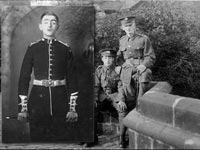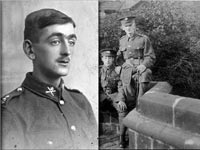
'THE GREAT WAR', 'THE WAR TO END WAR', 'WORLD WAR 1'
1914 - 1918
 |
EDWARD GARSIDE WHITEHEAD Guardsman 21718, 4th BATTALION GRENADIER GUARDS: Service No. 385 GUARDS MACHINE-GUN CORPS No. 2 Company Killed in Action 31st July 1917 3rd Battle of Ypres (Passchendaele) |
 |
With many page transcriptions from 'The Grenadier Guards in the Great War of 1914-1918' by Sir Frederick Ponsonby, to recount the actual organisation & battles in which the Grenadiers, in particular the 4th Battalion, took part. Pub. 1920 in 3 Volumes, . from Volume 2 |
|
Chapter XX Oct - Dec 1916 |
~~~~~~~~~~~~~~~~~~~~~~~~~~~~~~~~~~~~~~~~~~~~~~~~~~~~~~~~~~~~~~~ p. 148 CHAPTER XX THE battle of the Somme continued, and further gains by both the British and French armies were announced. On November 13 a successful offensive operation was carried out by the British Army on the Ancre. |
4th Battn. Sep-Oct 1916 |
~~~~~~~~~~~~~~~~~~~~~~~~~~~~~~~~~~~~~~~~~~~~~~~~~~~~~~~~~~~~~~~ p. 157 OCTOBER TO DECEMBER 1916 The 4th Battalion was sadly depleted after the battle of the Somme, having lost nearly half its number, and a reorganisation and redistribution of the officers and non-commissioned oflieers was therefore necessary. On the 28th September Major-General Feilding addressed the men on parade, and paid a great tribute to their share in the battle. On the 30th the 4th Battalion moved to the sandpits at Méaulte, and the next day to Morlancourt, where it got into motor buses belonging to the French, and proceeded via Amiens to Epaumesnil. There it remained for five weeks; the billets were good, the weather on the whole was fine, and 4th Battalion was able gradually to recover its spirits and normal proportions. Company training was carried out in addition to musketry practice on the rifle-range and Lewis-gun instruction. On the 4th Brigadier-General C.E. Corkran, commanding the 3rd Guards Brigade, addressed the Battalion on parade, and said that their splendid behaviour during the recent fighting could not have been surpassed. He thought that the part played by the Battalion in the battle of the Somme equalled in brilliance what it had achieved in any of the battles whose names were embroidered on the Regimental Colours. |
4th Battn. Oct - Dec 1916 |
~~~~~~~~~~~~~~~~~~~~~~~~~~~~~~~~~~~~~~~~~~~~~~~~~~~~~~~~~~~~~~~ p. 158-159 On November 1 Field-Marshal His Royal Highness the Duke of Connaught, accompanied by Colonel Sir Henry Streatfeild, inspected the Guards Division. On the 10th the Battalion left Epaumesnil, and was transported in French motor buses via Amiens to the sandpits at Méaulte. Two days later it moved to Carnoy, and on the 13th went up into the trenches in front of Lesboeufs and Gueudecourt, with two companies in the front line, one in support and one in reserve. The front line was much battered, and was also 3 feet deep in mud, which made the relief a matter of some difficulty. In addition to the continual sniping there was considerable activity on the part of the enemy's artillery, which resulted in a considerable number of casualties. The weather had now turned very cold, and it was freezing, with snow and rain at intervals. On the 17th the 4th Battalion retired to H Camp at Carnoy, where it remained until the end of the month. On the 19th Lieut.-Colonel Lord Henry Seymour left to take temporary command of the 2nd Brigade. On December 5 the 4th Battalion took over a line of trenches near Sailly-Saillisel, and two companies of the 2nd Battalion Scots Guards were attached. The front line was a long one, and there were no communication trenches, which made the relief more dangerous than usual. After four days, during which there was little shelling, the Battalion retired to Bouleaux Wood, and the next day proceeded to Bronfay Farm. On the 9th Lieut.-Colonel G.C. Hamilton arrived and took over command, and on the 14th the Battalion returned to the front line. During this relief the Germans put down a barrage, and Lieutenant H.J. Boyton was killed by a shell and a few men wounded. After the first day the shelling diminished considerably, and there were no more casualties, but the mud was as bad as ever. Private James behaved with the greatest gallantry the first night, and went over to bring in three men who were wounded within fifty yards of the enemy. There were again a certain number of casualties, and Lieutenant J.W.F. Selby-Lowndes was wounded. Returning to the line again on the 27th, the Battalion had a quiet time and suffered no casualties. |
Chapter XXI Jan - Mar 1917 |
~~~~~~~~~~~~~~~~~~~~~~~~~~~~~~~~~~~~~~~~~~~~~~~~~~~~~~~~~~~~~~~ p. 160-161 JANUARY, FEBRUARY, MARCH 1917 AT the beginning of 1917 events of the highest importance succeeded each other with startling rapidity. On the British front a series of operations was commenced on the Ancre, beginning at Sailly-Saillisel Ridge; and so successful was the British offensive that village after village was captured. The Germans adroitly retired to what was known as the Hindenburg line, and after Bapaume and Peronne had been captured Sir Douglas Haig pressed forward towards Cambrai on a 100-miles front. The French had some very stiff lighting between the Aisne and the Argonne, and also between Tahure and Massiges where the Germans broke through. There was still fighting round Verdun, and the Germans claimed some successes there; but, on the other hand, in conjunction with the British, the French made an advance between La Fere and St. Quentin. In Russia some progress had been made in the Bukovina and also near Riga, when a revolution broke out in Petrograd. The Czar was forced to abdicate, and Kerensky proclaimed a Russian Republic. Under the delusion that this change would assist either Russia. or the Allied cause, the British Government sent messages of congratulation. In Roumania the situation was hopeless, and the Germans were masters of Wallachia. The Greek Government accepted all the Allies demands, and even sent apologies; and when the junction of the French and the Italians in South Albania isolated Greece from the Central Powers, the activities of King Constantine in the German On January 31 the policy of unrestricted naval warfare was adopted by the Germans, who announced their intention of sinking every ship neutral or otherwise. With Russia in a state of revolution, the Germans calculated that they would be able to dispose of the other Allies before the United States Army was ready. This was a plausible theory, since with the tightening up of the submarine blockade there was some prospect of Great Britain being starved into submission before America could move. On February 3 the United States broke off diplomatic relations with the Central Powers and declared war. In Mesopotamia General Sir Stanley Maude commenced a series of brilliant operations which resulted in the fall of Kut-el-Amara on February 24, and the capture of Baghdad on March 11. In Palestine General Sir A. Murray succeeded in inflicting a blow on the Turks at Gaza, and took 900 prisoners, but these operations were only On March 13 China broke off diplomatic relations with Germany. |
4th Battn Jan 1917 |
~~~~~~~~~~~~~~~~~~~~~~~~~~~~~~~~~~~~~~~~~~~~~~~~~~~~~~~~~~~~~~~ p.171-172 THE 4TH BATTALION The officers of the 4th Battalion on January 1,1917, were : The first week in January was spent by the 4th Battalion at Mericourt, and on the 9th Major-General Feilding presented medal ribbons to the N.C.O.'s and men of the Battalion who had been awarded the Military Medal. On the 10th the Battalion proceeded to Billon Camp, where it was employed in road-making and improving the camp, and on the 14th it moved to Priez Farm. The weather was now very cold, and there was continual snow. Occasional shells reminded the men forcibly of the presence of the enemy, but there were no casualties. On the 18th the Battalion retired to Billon Camp, remaining there until the 25th, when it moved to Maurepas. The following day it took over the trenches immediately east of Rancourt on the edge of St. Pierre Vaast Wood. This part of the line was held by a series of posts or islands, which were duckboarded; it was a quiet spot, and there was practically no shelling. |
4th Battn Feb - Mar 1917 |
~~~~~~~~~~~~~~~~~~~~~~~~~~~~~~~~~~~~~~~~~~~~~~~~~~~~~~~~~~~~~~~ p. 172-173 After four days' rest the Battalion returned to the line, and during the relief came in for a heavy barrage, but after it had settled down, the shelling died away. On February 7 it was relieved, and retired to Maurepas. Two days later it went by train to Méaulte, and marched from there to Ville-sur-Ancre, where it remained till the end of the month going through the usual routine of training. The French War Minister General Lyautey, inspected the 3rd Guards Brigade, and was reported to have been much impressed by all he saw. On March 1 the Battalion moved to Bronfay, and on the following day to Combles with two companies at Haie Wood. There it went into the trenches until the 6th. During this tour it came in for a good deal of shelling, and Lieutenant B. Burman and seventeen other ranks were wounded. After four days rest at Fregicourt, the Battalion returned to the same line of trenches, but this time found everything far quieter. On the 13th it moved to Billon Camp, and on the 19th to Priez Farm, whence it moved up to the trenches for four uneventful days. On the 24th it retired to Bronfay Farm, and on the 27th marched to Clery, where it was employed on railway work. ~~~~~~~~~~~~~~~~~~~~~~~~~~~~~~~~~~~~~~~~~~~ Next part |
Part 1 * Edward enlists in Jan.1915; Transcripts: * formation of the 4th Battn. * Guards Division in 1915. |
|||
Part 4 Edward lands in France Oct. Transcripts: * Diary of the War- Oct., Nov., Dec., 1915; * 4th Battn. Oct - Dec |
Part 5 Edward transfers to Machine-Gun Guards Transcripts: * Diary of the War - Jan - Sept. 1916; * 4th Battn. Jan - Apr. 1916 |
||
This Part Transcripts: * Diary of the War - Oct to Dec 1916: * 4th Battn - Oct - Nov 1916; * Diary of the War - Jan - Mar 1917; * 4th Battn. Jan - Mar 1917 |
|||
Part 12 Transcripts: * Edward Killed in action in Battle of Boesinghe 31 July 1917 *3rd Battalion - Boesinghe 1st battalion - Boesinghe 4th battalion - Boesinghe |
Part 13
|
* Gallery of pictures & Maps |
|
'The Grenadier Guards in the Great War of 1914-1918' by Sir Frederick Ponsonby Pub. 1920 in 3 Volumes, is freely downloadable as .pdf files or can be read on-line. |
|||
Vol 1 HERE |
Vol 2 HERE |
Vol 3 HERE |
|
Contributed by Sheila Goodyear
World War 1 Project MENU PAGE |
Members' Pages MENU |